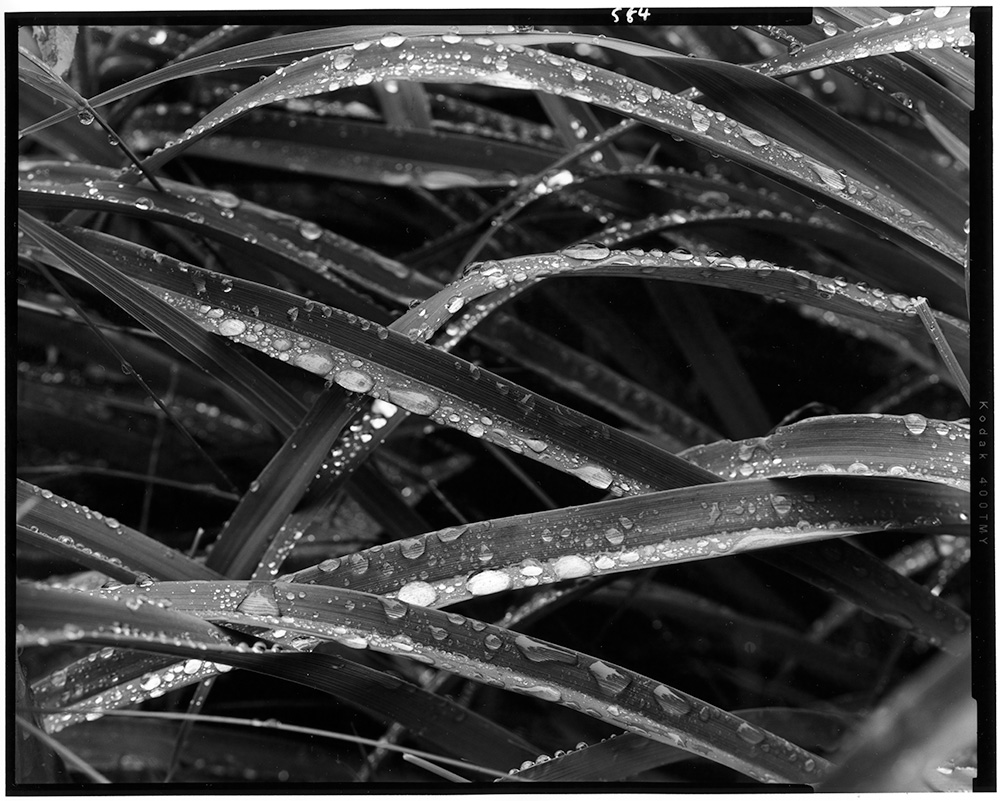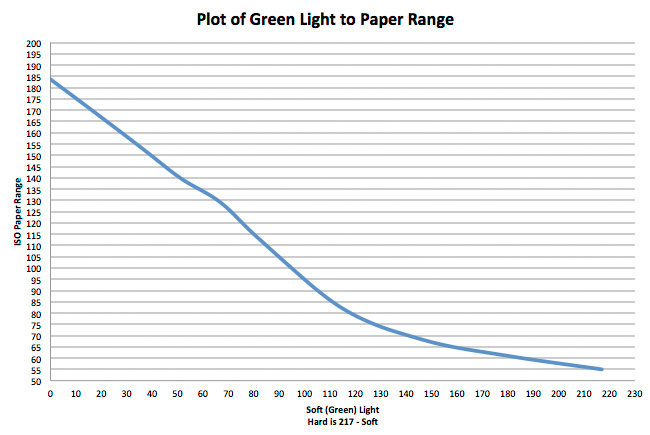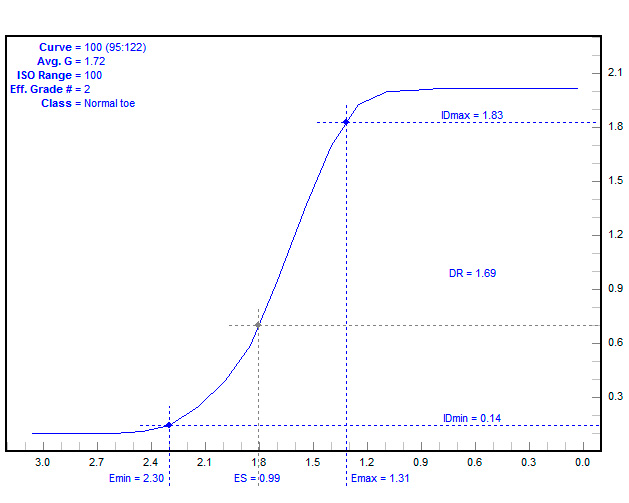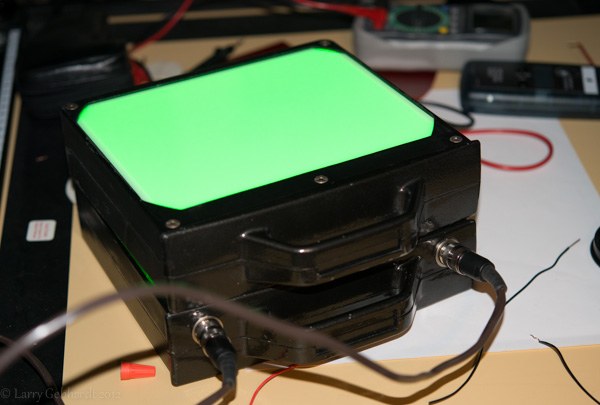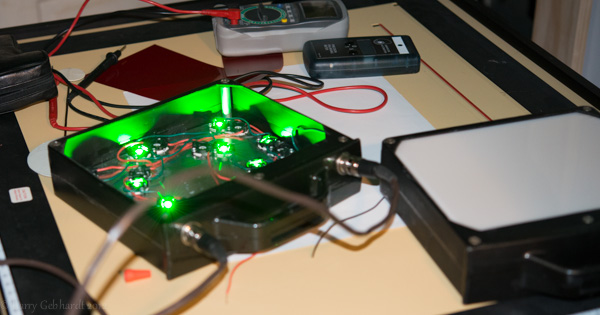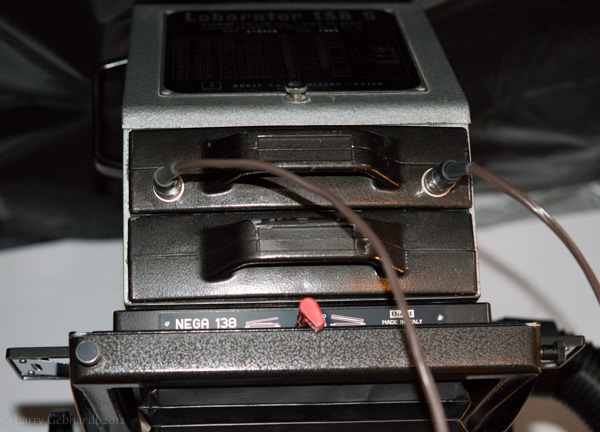I misplaced my Printo Manual, and spent way to long looking for it. Now that I’ve found it I scanned the English portion so I will always have a version I can find. I’m sharing it here since there doesn’t seem to be an English version on the web.
Darkroom
Years ago I found a laser sight that had a flat base. I’ve been using this to align my enlarger and it works very well. However I haven’t seen that model in years. Since I have frequently recommended building your own laser alignment tool I thought I would build a 3D printed stand to use the commonly available laser sights.
I have now released a 3D printed stand so you can build your own laser alignment tool.
Bulbs for some enlargers are getting hard to find. The opal bulbs for the Durst 138S condenser heads have been out of production for many years. Occasionally new ones still turn up, but they are expensive and hard to find. If you have a bulb you probably hope it won’t die on you until you can find, and maybe afford, a replacement. This was my situation when I got my 138S. I had one bulb that I thought was original (turns out it isn’t, but it works well). When I eventually acquired a few of the original Durst Atlas Thorn bulbs I was hesitant to use them for fear of burning them out.
I had known for a while that a bulb run through a dimmer will last longer, but I wasn’t sure how much longer. Still I thought it would be prudent to try to extend the life, so I bought a Variac off of ebay. These are transformers that take your line voltage and bump it up or down in an adjustable fashion. Mine will take 120V and transform it to 0 to 130V. It plugs into the wall and has two regular sockets on it that you can plug your enlarger into. A big knob controls the output voltage. The scale on mine doesn’t exactly match the output voltage, but it’s very repeatable, so I just marked a few positions with the actual voltage. I recommend testing the voltage with a multimeter (only if you know how to use one safely with AC line voltages) as you don’t want to accidentally run the bulb at more than its rated voltage.
I found with the 500 Watt bulb that each 10V drop decreased the light output by 1/2 a stop. I settled on 110V as the maximum that I would run the bulb at to extend its life. For smaller prints I generally find the 500 Watt bulb too bright even at 110V, so I run it at 70 to 90V which gets me one to two extra stops of time for easier dodging and burning.
What I haven’t known was how much this could extend the life span of the bulb. However I just found the May/June 2000 issue of Photo Techniques magazine (I got a whole stack of these with the enlarger) which surprisingly has an article, “Optimize Enlarger Light Intensity” by Conrad R. Hoffmann, on reducing the light output with a Variac. In the notes section he gives the formula to calculate how much the lamp life is affected by the voltage. The formula is (Design Voltage / Actual Volatge)^12. Yes that’s the 12th power, so a minor voltage change can have a huge effect. For example running the lamp at 110V will give a 2.84 longer lamp life. That right there more than pays for the cost of the Variac, which ran about $100 and is what I see the bulbs going for recently. Running at 70V will increase the life by 644 times. That may mean you no longer need to worry about burning it out.
One thing to note is that the color temperature of the light drops as the voltage drops. Mine went from 2800K at 110V to 2300K at 70V. This will change the contrast some with VC paper. I think I lost about 1/2 a grade when dropping to 70V. I suppose you can use this to get intermediate grades if your filters aren’t fine enough for you.
There are endless arguments about whether condenser printing or diffusion printing is best. Most of my experience is with diffusion printing with various color enlargers and most recently with the Ilford 500 head on an Omega D5. I tried the condenser head on the Omega, but not enough to gain an appreciation for it.
The Durst 138S has an excellent set of condensers. With the new enlarger I got a full set of the T condensers (T indicates they are coated).
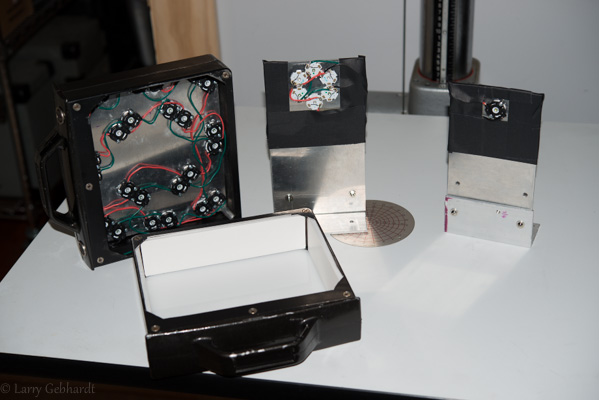
Three LED Light sources for the Durst 138S.
From the left 1) Variable Contrast diffusion, 2) Variable Contrast condenser, 3) point light
When I first got the Durst I didn’t have any choice but to print my 5×7 negatives with the condensers. I was able to get good results and found that the conventional wisdom on the subject is generally true. They really do print the same negative with more contrast. Prints do seem slightly sharper. The grain is better resolved. Scratches and dust on negatives is more apparent. But the conventional wisdom is wrong that a diffusion enlarger means you don’t need to spot as much. Diffusion still shows the dust, and it must still be taken care of.
The biggest issue I had with the condenser setup is that I can’t use pencil masking techniques. This is due to the fact the condenser setup relies on focusing an image of the light bulb at the nodal point of the lens. By adding an opaque mask above the negative you get some very uneven illumination since the condensers can no longer focus on the lens. Also, I lost the ability to finely adjust the contrast grade with VC papers, due to the use of VC filters only coming in 1/2 grade increments. This last part wasn’t much of an issue, but the loss of masking techniques was going to impact my printing.
So I built a diffusion light source for the enlarger, which is documented in a few posts. This is an LED diffusion head that has both green and blue LEDs for contrast control. This gave me the ability to print negatives with diffusion if I wanted to mask, but if I wanted the sharpness of the condensers I had to go back the old filtration control method with the hot tungsten bulb.
Another issue with the Durst 138S system is that it relies on large discontinued Opal bulbs. I have a few in various wattages now, and I found a PH/303 500watt bulb that works pretty well. The Opal bulbs are expensive and I doubt I’ll be able to find replacements as they get used up. The PH/303 runs pretty hot and requires a blower, which is a bit loud.
LED Condenser Light Source
I decided to build a head to get the advantages of the condensers along with the variable contrast control of the green and blue LEDs. I replaced the Opal bulb with a piece of milk glass that fits in the heat absorbing glass tray. Behind this I built an LED source with three green and three blue LEDs with the same specs as the ones used in the earlier head I built. I arranged these in a ring, alternating colors, on a piece of aluminum plate screwed to some aluminum angle iron. A few holes allow it to mount to the movable stage in the Durst head using the existing thumb screws. The plate also acts as heat sink. The LEDs were glued down with Arctic Alumina heat sink compound.
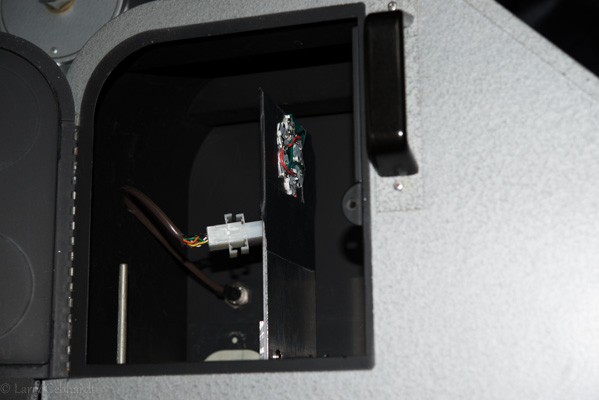
The Variable Contrast light source installed in the enlarger. Note the cable setup with a DIN plug mounted on the enlarger head wall and the quick connect plug on the light source.
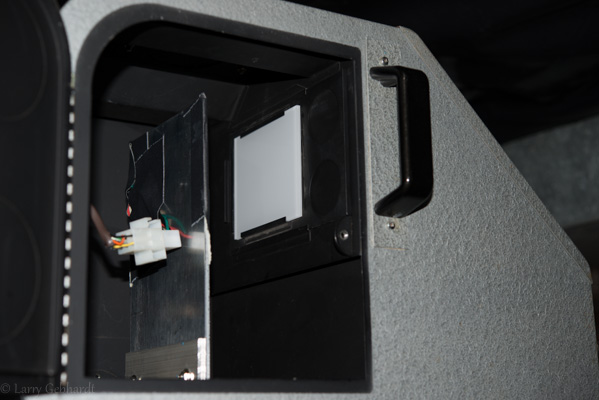
Another view of the VC light source showing the opal glass installed in the heat absorbing glass holder. Milk plexiglass works just as well here.
I also installed a matching DIN connector in the body of the Durst light chamber so I can simply plug one of the cables used for the diffusion head into this and reuse my controller and the LED drivers.
I’ve only printed a few negatives with this system, but in testing it works very well. The light source is as even as the original bulb (corners are 1/4 of a stop dimmer than the center), and contrast control works as it should. Because of the efficiency of the condenser design it’s only a 2/3 stop slower than the diffusion head, even though it’s using 1/4 of the LEDs. I’m not sure what else I could ask for.
LED Point Light Source
The Durst has an optional point source lighting system, which I haven’t used or seen. It occurred to me that while I was messing around with LEDs that I could build one with a single LED, since they are very small (almost a perfect point) and very bright. I took a single CREE High Noon LED that I know gives a very good light for printing on VC paper with filters. I mounted this on a similar place of aluminum as I had for the other source.
This is used without the diffusion glass in the heat absorbing tray. The Durst system comes with controls to adjust the position of the bulb in three dimensions. Once I figured out how to position the LED I was able to get very even coverage over the whole frame. Every time you adjust the enlarger height you need to reposition the bulb. I now appreciate how well the Durst controls work for this.
So how does it work? Well you need to use contrast filters again since it’s a single white light. The single LED used as a point source is several stops brighter than the other light sources. It’s so bright I needed to add a neutral density filter under the lens. With a point source setup you need to use the lens wide open, so you can’t adjust the brightness using the aperture ring.
I printed the same image with grass that I used to try out the diffusion head. First print was very sharp, but odd looking. Took me a while to realize it was the pattern from the anti-newton glass in the negative holder. I removed the glass and made another print. This looked good. The point source is much sharper than the diffusion head and quite a bit more contrasty. It also shows every little flaw in the negative. There are a few odd areas that are on the negative and can be seen with a good loupe. These are barely perceptible on the diffusion print, but are almost glaring on printed with the point light source.
I don’t have enough prints made with this setup to know if I’ll keep using it. But I can see how it could be really interesting with some grainy 35mm film and large enlargements. Should be very sharp, and have clearly defined grain. I plan to experiment.
Conclusion
I now have three different options that all work well in the Durst 138S. I can use the same F/stop based controller for them all, and switching them takes only minutes. I can now choose the best lighting type for each image or printing situation.
What’s next? Well I may buy an LED star that has a green and blue LED in very close proximity. This might allow me to have a variable contrast point source. It’s possible thought that even a few mm offset would not align correctly. It will run about $20 to test that out. I also plan to spend more time making prints and less making enlarger parts.
Over the weekend I got a box built for the controller and a separate one for the power supply. They are separate because I wanted to be able to move the unit around so it could be in a comfortable location. With the power supply, relay, safelight plugs and the LED drivers it was just too large. So I built a really ugly box out of sheet aluminum for the power supply. And I used a simple project box from Radio Shack to mount the Arduino with the keypad and display in. They are connected by an 8 conductor wire with RJ45 connectors (ethernet jacks and cable). This is nice and flexible, and since there’s very little power drawn by the controller it should be fine over the thin wire. Once I give the box a nice coat of hammered silver finish I’ll post some pictures so you all can laugh at my sheet metal skills.
I made my first print tonight using the system. It was a negative I took at lunch when the rain stopped (mostly) for a few minutes.
Shot on 4×5 T-Max 400 with a 210mm Macro Sironar and developed in Pyrocat HD in a Jobo Expert Drum. Printed on cheap Adorama RC paper.
The print is a straight print at an ISO Exposure Scale of 100 (grade 2). Despite the RC paper it looks really nice.
The head is fast as it’s setup. I needed to stop down to f/11 for the print and it was a 6 second exposure. I think this is over a stop faster than the condenser head, but I haven’t measured it. For small prints like this I want to build in a way to dim the lamps some more. That will require some changes to the code.
But so far everything worked well, except the test print mode. I screwed something up in that section of the code, and I realized as I went to use it that I had never tested it. So back to the editor it goes.
I’ve got a partial metal box made for the power supply and the LED drivers. This will also have relay to control the safe lights, and an additional power outlet that’s on opposite the safe lights. So this could also be used to drive a traditional enlarger. The box isn’t anything to look at right now, but once I make a top it’ll be electrically safe. I’ll post some pictures after it’s a bit more complete. At least it now holds all the parts together which allows me to test the system out.
I made some code changes to support calibration of different papers. I started with the idea of calibrating to the traditional paper grades, 00, 0, 1, 2, 3, 4, and 5; but there are really no standards for theses. And since they cover a range of contrasts it made programming the system rather confusing. So I settled on using the ISO system. This is easily measured using a simple densitometer and graph paper. It’s also fully supported by the BTZS Plotter app, which I use for testing.
The Variable Contrast Printing Manual by Stephen G. Anchell gives a good overview of how this works.
Papers will be eventually read off of an SD card, but for now I’ve been programming a default paper.
For testing I started by just running a simple test where as I increased the brightness on the soft LEDs I decreased the brightness on the hard LEDs. I kept the total at 217 (out of 255) on the PWM pins for the Arduino. This value was chosen because 217 is just below the cut off where the BuckBlock LED drivers start to flicker as they dim past this (0 is fully on at 1 amp, and 255 is fully off). I made exposures through a step wedge to arrive at this curve:
From this curve I reprogrammed the default paper curve in the Arduino code. This was done by looking up the grade I wanted on the vertical axis and finding the correct light ratio. I then reran the test strips at:
55 (Grade 4.x, as high as it goes on my paper and developer)
65 (Top of Grade 4)
80 (Top of Grade 3)
100 (Grade 2)
120 (Grade 1)
140 (Top of grade 0)
160 (Grade 0)
I could have run a strip at 180, but I never print this low and the Ilford MGIV has a really lumpy curve at this point, so I don’t really plan on using it. I would reduce my negative or change paper developers before printing with pure green light.
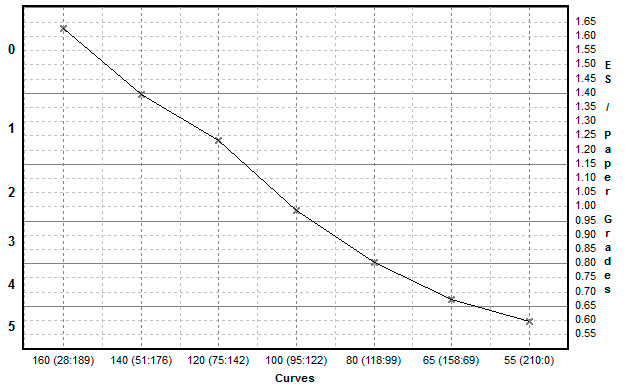
Once these curves were put in BZTS Plotter I got this graph which shows that the system is working pretty well. I could tweak things to make it more linear, but it tracks better than any other head I have used. Now I should know easily how much contrast I will get out of any change, and by reading the negative should be able to zero in on a decent starting contrast easily. Once the system is packaged up I’ll make more accurate curves for each paper I plan to use. That will let me switch papers easily since an ES of 100 should print with the same contrast on both papers (of course there will be visible differences, but the overall contrast should be the same).
The chart shows the input grade on the bottom axis, and the calculated grade on the vertical axis in both ISO Exposure Scale and traditional paper grades.
Currently I have the system setup to allow changes in 5 ES increments. This seems like a good compromise between precision and keeping the system easy to profile. I’m also not sure if a 1 ES change would even be noticeable, or repeatable between exposures.
Next I will solder up a prototype board. I’ll test it an then decide if I need any changes before committing to designing and ordering a few printed circuit boards.
I’ve been slowly making progress on the VC LED head. I choose to tackle this as two separate steps; the head and the controller. What you see here are the two pieces of the head resting on the baseboard of my Durst 138S. I choose this configuration to allow me to quickly switch from this diffusion light source back to the original condenser head. What I did was take two scratched condensers and removed the glass. One was a 240mm and I used it for the top part (bottom in the picture). Into this I drilled two holes on the front for 6pin Din connectors. On the inside I mounted a sheet of 1/4″ aluminum for a heat sink and support for the LEDs. This is held in place by the original Durst screws and some aluminum tubing over them cut to fit snuggly. In the other condenser shell I mounted a piece of 1/8″ translucent white plexiglass, which is held in place with white foam core around the edges. First I needed to cut some of the metal from shell since this was for a smaller 130mm condenser. A metal blad in a jig saw made quick work of this since the shells are aluminum.
The LEDs are Cree XP-E Green for the soft light and Cree XT-E Royal Blue for the hard light. There are 12 of each arranged in two banks. This arrangement was chosen based on the capabilities of the controllers I am using. I originally was going to go with a Mean Well 60-48D which could drive all 12 LEDs in each bank, but I found it didn’t dim quickly enough to allow the dimming feature to turn the lights on and off. After a bit of research I settled on using A009-D-V-1000 BuckBlocks, which offer a lot of options for control, and respond instantly to dimming commands. The only issue is they don’t have enough forward voltage to drive more than 6 or 7 of these high power LEDs.
I was originally only going to have one cable to feed power to the head, but I found out the hard way that each BuckBlock must have it’s own ground wire along with hot wire, so my 6pin Din connectors don’t have enough pins for all the needed wires. For reference when I hooked two of the controllers up with the negative wire as common when one was dimmed the excess current is fed into the other bank of LEDs. When I checked 2A were flowing through my 6 green LEDs (rated for 1A maximum). They still work, but I do wonder how much of their life I used up in the minute or two it took to figure out what was going on.
Right now they are hooked up a bank of 4 10K potentiometers. This allows me to adjust the brightness of each bank for testing purposes. The head is even to less than 1/3 of a stop across most of the surface. The very corners are about 1/3 stop dimmer than the rest. Given the arrangement of the LEDs I can adjust (in software) to bring the far edges and corners up in relation to the center. Doing this gets me a very even light source. On the baseboard (factoring in lens falloff) it’s even to about 1/5 of a stop. I might be able to tweak this more, but it’s better than any of my other enlargers, though I haven’t made any prints with it yet.
I think I may want to get some right angle connectors for the cables. I’d also like to get a more flexible wire for the cords. But other than that I am pretty happy with this first phase of the project.
I have also been experimenting with the Arduino based controller for all of this. The BuckBlocks can be controlled with a PWM signal and a simple 2N2222 transistor (see their data sheet for wiring diagram). This should make wiring up the system fairly easy. They also respond instantly this way from off then to fairly dim up to full brightness.
I’m still working on the software and board design, but I’ve checked a preliminary version of the controller code into GitHub. This is based on William Brodie-Tyrrell’s F/Stop Timer. This is very preliminary, but I’m trying to get it working in both a split grade and integrated mode. Feel free to fork the code and send me a pull request if you want to add a cool feature.
I have been printing with the condenser head on my Durst 138S. I use Ilford multigrade filters in the filter drawer for contrast control. I like the sharpness of the grain that the condensers give, and there’s something satisfying about sliding the correct condensers into the slots, due I think to their heft and how well built the machine is. But, and there’s always a ‘but’, when I want to make use of a dodge and burn mask I can’t. This is an inherent limitation of the condenser system which essentially focuses an image of the light source (bulb) through the negative and into the center of the enlarger lens. This collimated light is what’s responsible for the perceived sharpness of the prints. But it means that adding a diffusion layer as needed by the dodge / burn / pencil masks breaks the design.
I tried various methods of diffusing the existing light, but the results were wither too dim for large prints, or too uneven. So I decided to build my own light source. I had used white LEDs to make a simple head before, which worked pretty well. It was simply a bank of high power LEDs and a constant current controller which plugged into a timer. I thought about rebuilding this to fit the Durst. But given it’s a 5×7 enlarger I can’t find contrast filters large enough to fit above the negative, and I wanted to avoid under the lens filters (partially since the current set isn’t big enough to fit under the 210mm lens I have). I also enjoyed being able to set the contrast in finer steps than 1/2 a grade when I was using an Ilford 500 head on the 4×5 Omega.
So I’ve decided to build a variable contrast head. This will use two colors of LEDs; green for the soft grades; blue for the hard grades. By varying the intensity between them I should be able to produce any grade between the two extremes.
Parts have been ordered, and I’ve been playing with the LEDs and controllers. I’ll post some updates soon.
I scanned the users manual and the service manual for the Durst Laborator 138S enlarger in case anyone else needs them. I haven’t seen the service manual posted online before, and the instructions are a different version from what is posted at Durst Pro. Hope these help someone.
Durst 138S Service Instructions
edit: Here’s one more version of the instructions
About a year ago I bought a Durst Laborator 138S enlarger to handle 5×7 negatives. The enlarger I bought showed signs of heavy use, and seems to have come from a university darkroom. I would have sent it back, but the freight shipping cost as much as the enlarger. So I set about replacing some parts that turned out to be missing, and a few that were very worn such as the stage for the negative carrier and bellows. It took about 4 months but eventually I had a nicely working 5×7 enlarger.
So why did I just buy another one? I don’t know. I found one on ebay within a day’s drive for a decent price. It’s a complete package in excellent condition. The condensers are pristine, the negative carrier is in nicer condition than the one I picked up for the other 138S, and it’s of the newer style that can take a lens turret or a large lens plate. It also has a couple of original Durst bulbs in various sizes.
I picked it up last weekend and now the my office is filled with Durst parts as I decide how I’m going to fit it into the darkroom. I haven’t decided if I’m keeping the old one too and retire the Omega D5 enlargers, or if I’ll replace the older Durst with the new one and keep the Omegas going for color and to use the Ilford 500 head. Maybe I need to build a larger darkroom 😉
The seller of the Durst was winding down his darkroom usage so I also picked up a few other items including a Micromega grain focuser, Harrison changing tent and forced air print drying unit that he was selling.


